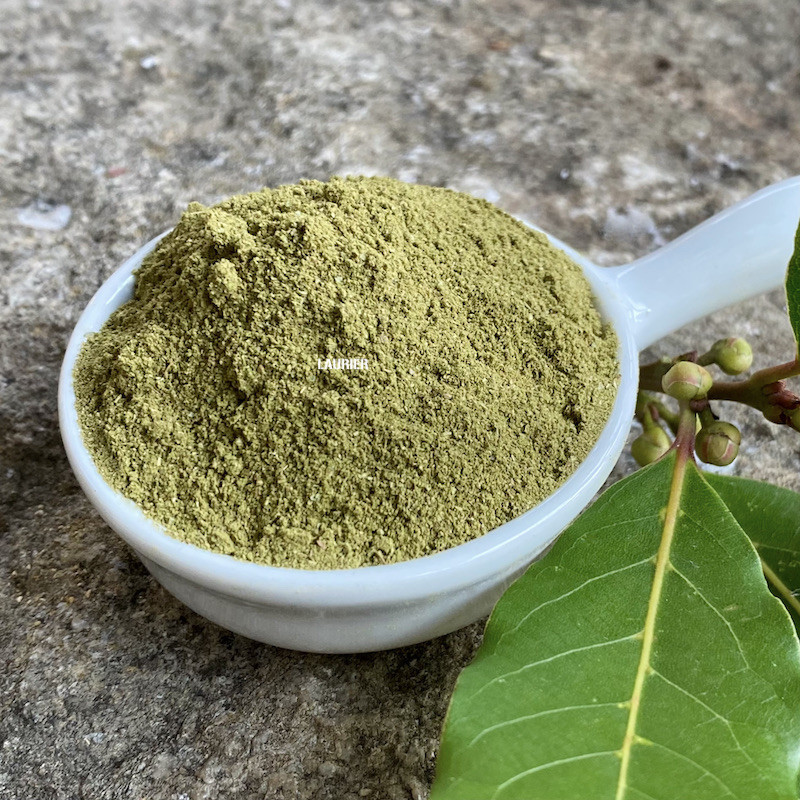
Reference: 021122


Its unique fragrance, inspired by pine essence, comes from its high content of essential oils.
Its powder will subtly blend into all your dishes, sauces, meats, or mustards.
 Delivery
Delivery
Mondial Relay
 Returns
Returns
See conditions
 Payments
Payments
100% secure
Livré en sachet refermable
Uses in Cooking and Beyond:
The aroma of this powder is much more powerful than that of the whole leaf. Bay laurel thrives in the sun, and its leaves ground into powder will blend seamlessly into all your cooked dishes, instantly imparting their delightful fragrance. There’s no need for long cooking to enjoy their distinctive flavor; you can simply sprinkle the bay powder on your preparation as easily as you do with salt!
This powder is extremely fine and will be undetectable to the bite! That's why you can use it to flavor mayonnaise, vegetable juices, instant soups, shortcrust pastry for a pie, or even to customize a plain store-bought mustard (or to flavor your homemade mustard!). It will also be perfect in your classic sauces, marinades, and meat stews!
The leaves of the bay laurel release a very characteristic scent when crushed or ground, somewhat reminiscent of pine needles. Occasionally, the flowers and berries can also be used, with properties similar to those of the leaves.
Bay laurel aids digestion when consumed during or after a meal, but it acts as an appetite suppressant if taken before a meal.
In North Africa, fresh bay leaves are rubbed on horses to keep flies away.
The oil extracted from the crushed berries of the tree is used in the production of Aleppo soap. This is where its great difference from Marseille soap lies, as the latter does not contain it. This bay oil is very expensive, as the berries are small and in low proportion compared to the leaves of the tree. The more there is in Aleppo soap, the more expensive it is, but also the more numerous its virtues!
Who am I?
Origin: Turkey
Scientific name: Laurus nobilis
Nicknames: True laurel, noble laurel, sweet bay
Bay laurel is a large shrub from the Mediterranean regions with evergreen foliage, belonging to the Lauraceae family, sometimes reaching up to 15 meters in height, with a straight and gray trunk at the bottom and green at the top. The leaves, measuring up to 10 cm in length, are lanceolate, leathery, with slightly wavy edges, dark green on top and more silver on the underside.
The small white or yellowish flowers, clustered in the leaf axils, appear in March-April. The fruit is a small oval berry, dark purple in color, about the size of a large peppercorn.
The leaves, flowers, and even the roots of bay laurel contain essential oils representing 3% of their dry weight!
It is essential not to confuse bay laurel with oleander, a beautiful shrub that forms many lovely flowering hedges in the South of France. Indeed, the two shrubs are not at all in the same family, and oleander is very toxic!
A little history:
Laurel has always been a symbol of peace.
The Romans used bay branches as ornaments for victors, giving rise to the term "laureate," which we still use today, as well as various expressions such as "to receive laurels" to denote receiving an award.
In medical schools, the crown that adorned the heads of young doctors was made of laurel branches bearing leaves and berries, hence the term "baccalaureate" (derived from "laurel berry") still in use today.
Data sheet
Reference: 021122
Reference: 12N7952502
Reference: 3N7201902
Reference: 30711601
Reference: coriandreE
Reference: 9N7655101
Reference: 20815801
Reference: cardamomeM
Reference: origan
Reference: 050721
Reference: 12N7952502
Reference: laurierE
Reference: 11N7866301
Reference: oignonblc
Reference: echalote

Its unique fragrance, inspired by pine essence, comes from its high content of essential oils.
Its powder will subtly blend into all your dishes, sauces, meats, or mustards.